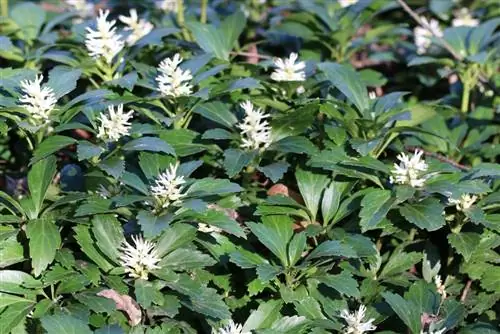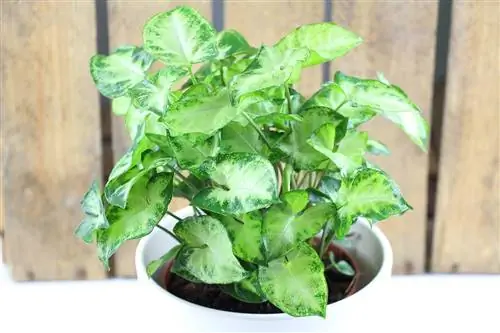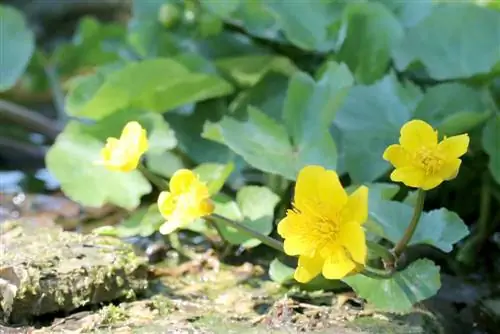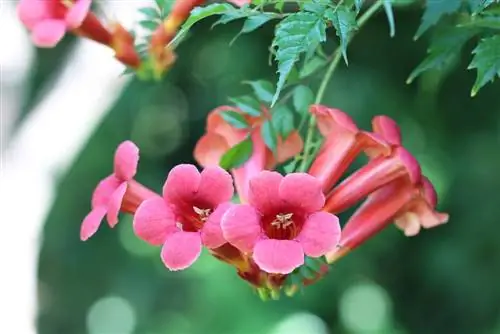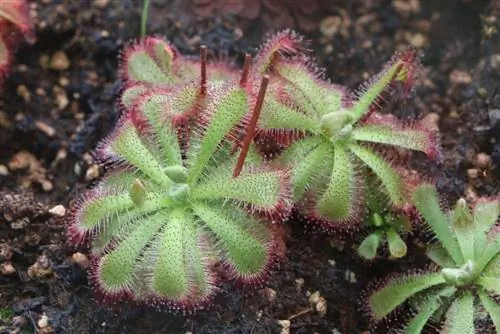- Author admin [email protected].
- Public 2023-12-17 03:39.
- Last modified 2025-01-24 12:45.
The fat man, also called shadow green or Japanese Ysander, belongs to the boxwood family. Like the related boxwood, the Ysander is poisonous, but is still a popular ground cover that thrives in almost all soils. Thanks to its rhizomes (underground runners), it spreads quite widely. Since it also converts falling leaves into humus, it is the ideal underplant for deciduous trees.
The ideal location
As the nickname shadow green suggests, the Ysander likes to grow in the shade, regardless of whether this is complete shade or light shade (partial shade). It grows very well under park and garden trees. This shows a rich green leaf color. In a sunny location the leaves often turn yellowish. This is a sign that your Ysander is not really feeling well. It should at least be watered here more often. In principle, however, the Ysander prefers a rather cool location.
The right floor
When it comes to soil, the Ysander doesn't have any great demands. Although it prefers moist soil, it can also cope with slightly drier soil as long as it is not in the blazing sun. However, it does not tolerate lime very well; the pH value should rather be in the slightly acidic range. If the soil is loose and humus-rich, the roots of the Ysander can spread easily. Soil that is too firm can be loosened up a little by mixing in fine gravel or sand. The Ysander itself “processes” falling leaves into humus and thus improves the soil for itself and the neighboring plants and trees.
Tip:
As a so-called leaf eater, the fat man improves the soil under your garden trees and keeps it moist. The trees growing above the Ysander also benefit from this.
The sowing
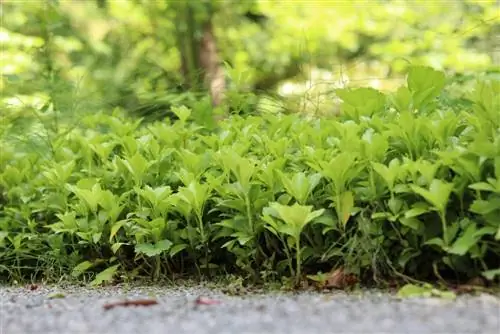
Ysander does produce seeds after it flowers from April to May, but sowing with it is rarely successful. This is because most plants on the market are hybrid varieties. As a rule, these do not produce germinable seeds and are sterile. In addition, other forms of propagation such as planting cuttings or propagation by root division are significantly more successful and less time-consuming.
The correct planting distance
Even if the Ysander spreads on its own, you should not plant the individual plants too far apart. A distance of approx. 20 to 30 centimeters is completely sufficient. A dense carpet of plants will soon form, with hardly any wild herbs growing in between. Weeding will then be a thing of the past, at least at this point in your garden.
Even if you want to quickly have a closed carpet of plants, you should not plant your fat men too close to each other. This only leads to the individual plants not rooting so well and hindering each other's growth.
Planting and transplanting
You can basically plant the Ysander in your garden all year round, as long as the ground is not frozen. However, planting in winter is not recommended. Like any other plant, Ysander needs a certain amount of time to grow. If the ground is frozen during this time, rooting is not possible and the freshly planted Ysander cannot supply itself with sufficient water or nutrients. The ideal planting times are spring and early autumn, then your Ysander will be well established by winter.
Planting step by step:
- Check the distribution of plants in the bed (7 to 12 plants per square meter, depending on size)
- Dig planting holes slightly larger than the root ball
- put some fertilizer, compost or horn shavings in the hole
- Insert plant
- Fill the hole with soil
- Press earth
- Water the plant well
Watering and fertilizing
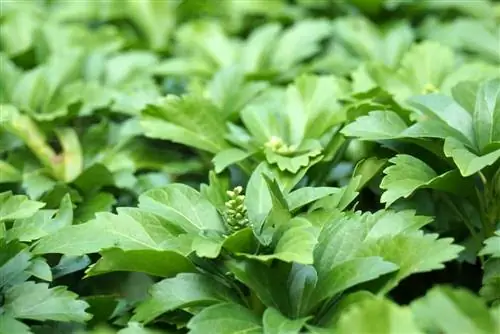
Slightly moist soil is good for Ysander. Therefore, you should water it a little every now and then if it is dry for a long time. The more sun the plant gets, the higher the water requirement of the fat man. Fertilizing is not necessarily necessary, but sometimes it is very helpful. This is especially true in very poor soil. In the fall, work a little mature compost into the area. Be careful not to injure the roots too much. Although the robust Ysander will recover from this, you will save the plant the additional stress if you proceed carefully.
Cutting
Pruning is not really necessary for Ysander. It grows quite well, but rather slowly. If you want your plant carpet of shade green to be particularly dense, cut the young plants back a little in the first autumn after planting. This encourages increased budding.
If you don't want the Ysander to spread too far in your garden, then cut off the runners at the edge of the plant carpet regularly. Parting with a spade is also possible. If you wish, you can cut the shadow green a little into shape.
Propagate
The Ysander spreads on its own. If propagation is still desired, then this is possible in different ways. You can choose to divide your plants or propagate them using root pieces, but also cut cuttings from them or simply plant their runners.
Share Ysander
If you want to divide your Ysander, all you need to do is separate the root ball into two or more pieces with a clean and sharp spade. You can simply replant the plants obtained in this way at the desired location. Don't forget to water the small plants well.
Planting runners or offshoots
The Ysander spreads all by itself via its rhizomes (underground roots). If you want to help him with this or plant the young plants in another location, this is possible without any problems. Simply dig up some of the runners (if possible already rooted) and put them back in the desired location. But here too, pay attention to the correct planting distance. In the beginning you should keep the soil evenly moist, this makes it easier for the shade green to form new roots. In this way you can propagate the Ysander almost all year round, except in winter.
Cut cuttings
In spring or early autumn, cut off shoots about 10 cm long and remove the lower leaves and inflorescences, if any. Simply stick the shoots treated in this way into the ground. If you keep your cuttings evenly moist, they will soon form new roots. This means you can cover a larger area with greenery within a relatively short period of time.
The fat man in winter
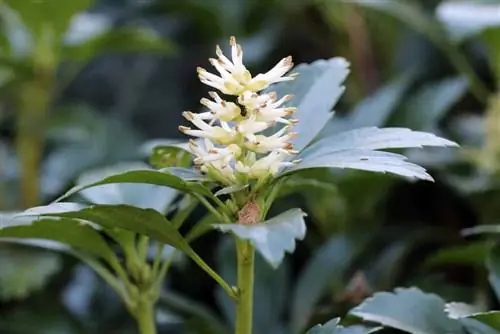
The Ysander is robust and very hardy. Since it is also an evergreen plant and often covers a larger area, your garden will never appear bare at any time of the year. The Ysander does not need any special care even in winter.
Diseases and pests
The robust Ysander is hardly affected by diseases and pests, especially not if the plant is he althy and in a well-suited location. However, disease can cause significant damage to your shade greenery. This is the so-called Volutella leaf spot and stem rot. It is caused by a very specific fungus that only affects the Ysander (bot. Pachysander terminalis). It's called Volutella pachysandricola and almost only occurs on weak plants. This disease is sometimes confused with rot, which can also occur in Ysander if it is too moist or wet.
Symptoms of Volutella leaf spot and stem rot
In the beginning, black or brown spots usually appear on the leaves. Later you can clearly see the pink fruiting bodies on the stems and underside of the leaves. The Ysander is increasingly losing leaves and the affected shoots become soft and black. You can no longer help the affected plants, but if you intervene quickly, you might be able to save the rest of your little ones. Immediately remove all affected plants including the soil attached to the roots. Under no circumstances should you plant Ysander in this spot again right away, but wait a few years. The fungal spores can survive in the soil for a long time and then very quickly infect the newly planted plants. In the meantime, green manure is recommended.

